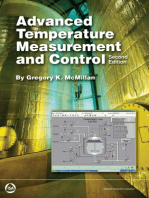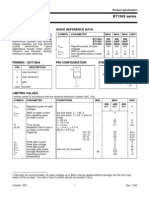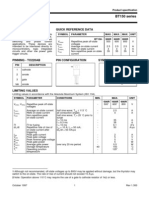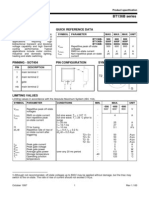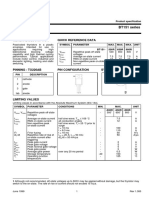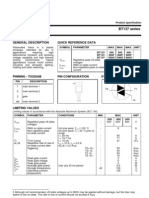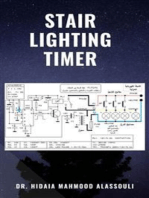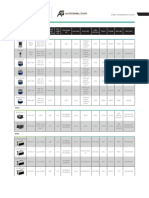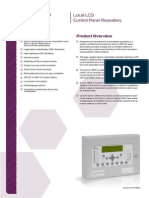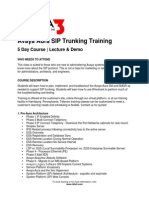Thyristors BT258U Series Logic Level: General Description Quick Reference Data
Thyristors BT258U Series Logic Level: General Description Quick Reference Data
Uploaded by
Miloud ChouguiCopyright:
Available Formats
Thyristors BT258U Series Logic Level: General Description Quick Reference Data
Thyristors BT258U Series Logic Level: General Description Quick Reference Data
Uploaded by
Miloud ChouguiOriginal Title
Copyright
Available Formats
Share this document
Did you find this document useful?
Is this content inappropriate?
Copyright:
Available Formats
Thyristors BT258U Series Logic Level: General Description Quick Reference Data
Thyristors BT258U Series Logic Level: General Description Quick Reference Data
Uploaded by
Miloud ChouguiCopyright:
Available Formats
Philips Semiconductors
Product specification
Thyristors logic level
GENERAL DESCRIPTION
Passivated, sensitive gate thyristors in a plastic envelope, intended for use in general purpose switching and phase control applications. These devices are intended to be interfaced directly to microcontrollers, logic integrated circuits and other low power gate trigger circuits.
BT258U series
QUICK REFERENCE DATA
SYMBOL VDRM, VRRM IT(AV) IT(RMS) ITSM PARAMETER BT258URepetitive peak off-state voltages Average on-state current RMS on-state current Non-repetitive peak on-state current MAX. MAX. MAX. UNIT 500R 500 5 8 75 600R 600 5 8 75 800R 800 5 8 75 V A A A
PINNING - SOT533
PIN NUMBER 1 2 3 tab DESCRIPTION cathode anode gate
PIN CONFIGURATION
SYMBOL
3
MBK915
anode
Top view
LIMITING VALUES
Limiting values in accordance with the Absolute Maximum System (IEC 134). SYMBOL PARAMETER CONDITIONS MIN. half sine wave; Tmb 111 C all conduction angles half sine wave; Tj = 25 C prior to surge t = 10 ms t = 8.3 ms t = 10 ms ITM = 10 A; IG = 50 mA; dIG/dt = 50 mA/s -40 MAX. -500R -600R -800R 5001 6001 800 5 8 75 82 28 50 2 5 5 5 0.5 150 1252 UNIT V A A A A A2s A/s A V V W W C C
VDRM, VRRM Repetitive peak off-state voltages IT(AV) IT(RMS) ITSM Average on-state current RMS on-state current Non-repetitive peak on-state current
I2t dIT/dt IGM VGM VRGM PGM PG(AV) Tstg Tj
I2t for fusing Repetitive rate of rise of on-state current after triggering Peak gate current Peak gate voltage Peak reverse gate voltage Peak gate power Average gate power over any 20 ms period Storage temperature Operating junction temperature
1 Although not recommended, off-state voltages up to 800V may be applied without damage, but the thyristor may switch to the on-state. The rate of rise of current should not exceed 15 A/s. 2 Note: Operation above 110C may require the use of a gate to cathode resistor of 1k or less. March 1999 1 Rev 1.000
Philips Semiconductors
Product specification
Thyristors logic level
THERMAL RESISTANCES
SYMBOL Rth j-mb Rth j-a PARAMETER CONDITIONS MIN. -
BT258U series
TYP. 70
MAX. 2.0 -
UNIT K/W K/W
Thermal resistance junction to mounting base Thermal resistance in free air junction to ambient
STATIC CHARACTERISTICS
Tj = 25 C unless otherwise stated SYMBOL IGT IL IH VT VGT ID, IR PARAMETER Gate trigger current Latching current Holding current On-state voltage Gate trigger voltage Off-state leakage current CONDITIONS VD = 12 V; IT = 0.1 A VD = 12 V; IGT = 0.1 A VD = 12 V; IGT = 0.1 A IT = 16 A VD = 12 V; IT = 0.1 A VD = VDRM(max); IT = 0.1 A; Tj = 110 C VD = VDRM(max); VR = VRRM(max); Tj = 125 C MIN. 0.1 TYP. 50 0.4 0.3 1.3 0.4 0.2 0.1 MAX. 200 10 6 1.5 1.5 0.5 UNIT A mA mA V V V mA
DYNAMIC CHARACTERISTICS
Tj = 25 C unless otherwise stated SYMBOL dVD/dt tgt tq PARAMETER Critical rate of rise of off-state voltage Gate controlled turn-on time Circuit commutated turn-off time CONDITIONS VDM = 67% VDRM(max); Tj = 125 C; exponential waveform; RGK = 100 ITM = 10 A; VD = VDRM(max); IG = 5 mA; dIG/dt = 0.2 A/s VD = 67% VDRM(max); Tj = 125 C; ITM = 12 A; VR = 24 V; dITM/dt = 10 A/s; dVD/dt = 2 V/s; RGK = 1 k MIN. 50 TYP. 100 2 100 MAX. UNIT V/s s s
March 1999
Rev 1.000
Philips Semiconductors
Product specification
Thyristors logic level
BT258U series
8 7 6 5 4 3 2 1 0
Ptot / W
conduction form angle factor degrees a 30 4 60 2.8 90 2.2 120 1.9 180 1.57
BT150
Tmb(max) / C a = 1.57 1.9
109 111 113 115 117 119 121 123
80 70 60 50 40 30 20 10 0
ITSM / A
BT258 IT I TSM
2.2 2.8 4
time T Tj initial = 25 C max
3 IT(AV) / A
125 6
10 100 Number of half cycles at 50Hz
1000
Fig.1. Maximum on-state dissipation, Ptot, versus average on-state current, IT(AV), where a = form factor = IT(RMS)/ IT(AV).
BT150
Fig.4. Maximum permissible non-repetitive peak on-state current ITSM, versus number of cycles, for sinusoidal currents, f = 50 Hz.
1000
ITSM / A
24 20 16 12
IT(RMS) / A
BT150
dI T/dt limit 100 I TSM T time
IT
8 4 0 0.01
Tj initial = 25 C max 10 10us 100us T/s 1ms 10ms
0.1 1 surge duration / s
10
Fig.2. Maximum permissible non-repetitive peak on-state current ITSM, versus pulse width tp, for sinusoidal currents, tp 10ms.
IT(RMS) / A BT258 111 C
Fig.5. Maximum permissible repetitive rms on-state current IT(RMS), versus surge duration, for sinusoidal currents, f = 50 Hz; Tmb 111C.
VGT(Tj) VGT(25 C)
9 8 7 6 5 4 3 2 1
1.6 1.4 1.2 1 0.8 0.6
BT151
0 -50
50 Tmb / C
100
150
0.4 -50
50 Tj / C
100
150
Fig.3. Maximum permissible rms current IT(RMS) , versus mounting base temperature Tmb.
Fig.6. Normalised gate trigger voltage VGT(Tj)/ VGT(25C), versus junction temperature Tj.
March 1999
Rev 1.000
Philips Semiconductors
Product specification
Thyristors logic level
BT258U series
3 2.5 2 1.5 1 0.5
IGT(Tj) IGT(25 C)
BT150
30 25
IT / A Tj = 125 C Tj = 25 C
Vo = 0.99 V Rs = 0.0325 ohms
BT150+
20 15 10 5 0
typ
max
0 -50
50 Tj / C
100
150
0.5
1 VT / V
1.5
Fig.7. Normalised gate trigger current IGT(Tj)/ IGT(25C), versus junction temperature Tj.
IL(Tj) IL(25 C)
Fig.10. Typical and maximum on-state characteristic.
3 2.5
BT150
10
Zth j-mb (K/W)
BT150
2 1.5 1 0.5 0 -50
0.01 10us 0.1ms 1ms 10ms tp / s 0.1s 1s 0.1
P D tp
50 Tj / C
100
150
10s
Fig.8. Normalised latching current IL(Tj)/ IL(25C), versus junction temperature Tj.
IH(Tj) IH(25 C)
Fig.11. Transient thermal impedance Zth j-mb, versus pulse width tp.
dVD/dt (V/us)
3 2.5 2 1.5 1 0.5
BT150
1000
RGK = 100 ohms
100
10
0 -50
50 Tj / C
100
150
50 Tj / C
100
150
Fig.9. Normalised holding current IH(Tj)/ IH(25C), versus junction temperature Tj.
Fig.12. Typical, critical rate of rise of off-state voltage, dVD/dt versus junction temperature Tj.
March 1999
Rev 1.000
Philips Semiconductors
Product specification
Thyristors logic level
MECHANICAL DATA
Dimensions in mm Net Mass: 1.3 g
BT258U series
Plastic single-ended package (Philips version of I-PAK); 3 leads (in-line)
SOT533
E E1 D1 mounting base D A1
1 e1 e
2 b
3 w M c
2.5 scale
5 mm
DIMENSIONS (mm are the original dimensions) UNIT mm A 2.38 2.22 A1 0.89 0.71 b c D 7.28 6.94 D1 1.06 0.96 E 6.73 6.47 E1 5.36 5.26 e e1 L 9.8 9.4 Q 1.00 1.10
0.89 0.56 0.71 0.46
4.57 2.285
OUTLINE VERSION SOT533
REFERENCES IEC JEDEC TO-251 EIAJ
EUROPEAN PROJECTION
ISSUE DATE 99-02-18
Fig.13. SOT533 (TO251). pin 2 connected to mounting base.
March 1999
Rev 1.000
Philips Semiconductors
Product specification
Thyristors logic level
DEFINITIONS
Data sheet status Objective specification Product specification Limiting values
BT258U series
This data sheet contains target or goal specifications for product development. This data sheet contains final product specifications.
Preliminary specification This data sheet contains preliminary data; supplementary data may be published later.
Limiting values are given in accordance with the Absolute Maximum Rating System (IEC 134). Stress above one or more of the limiting values may cause permanent damage to the device. These are stress ratings only and operation of the device at these or at any other conditions above those given in the Characteristics sections of this specification is not implied. Exposure to limiting values for extended periods may affect device reliability. Application information Where application information is given, it is advisory and does not form part of the specification. Philips Electronics N.V. 1999 All rights are reserved. Reproduction in whole or in part is prohibited without the prior written consent of the copyright owner. The information presented in this document does not form part of any quotation or contract, it is believed to be accurate and reliable and may be changed without notice. No liability will be accepted by the publisher for any consequence of its use. Publication thereof does not convey nor imply any license under patent or other industrial or intellectual property rights.
LIFE SUPPORT APPLICATIONS
These products are not designed for use in life support appliances, devices or systems where malfunction of these products can be reasonably expected to result in personal injury. Philips customers using or selling these products for use in such applications do so at their own risk and agree to fully indemnify Philips for any damages resulting from such improper use or sale.
March 1999
Rev 1.000
You might also like
- OFDM Wireless LANS, A Theoretical and Practical Guide - Juha HeiskalaDocument275 pagesOFDM Wireless LANS, A Theoretical and Practical Guide - Juha Heiskalana_hariprsadNo ratings yet
- Advanced Temperature Measurement and Control, Second EditionFrom EverandAdvanced Temperature Measurement and Control, Second EditionNo ratings yet
- Oracle SCM Training ManualDocument14 pagesOracle SCM Training ManualMohammad Younus Anwar QureshiNo ratings yet
- 2021-A Complete Guide To Stepwise Regression in RDocument4 pages2021-A Complete Guide To Stepwise Regression in RLuis GarretaNo ratings yet
- Industrial Applications of Infrared Thermography: How Infrared Analysis Can be Used to Improve Equipment InspectionFrom EverandIndustrial Applications of Infrared Thermography: How Infrared Analysis Can be Used to Improve Equipment InspectionRating: 4.5 out of 5 stars4.5/5 (3)
- Gen. Math Summary of Topics2Document7 pagesGen. Math Summary of Topics2Rann M100% (1)
- Cat 140MDocument28 pagesCat 140MWicca GenesisNo ratings yet
- BT138FDocument7 pagesBT138FMiloud ChouguiNo ratings yet
- BT168Document6 pagesBT168Miloud ChouguiNo ratings yet
- BT258XDocument6 pagesBT258XMiloud ChouguiNo ratings yet
- BT134WDocument7 pagesBT134WMiloud ChouguiNo ratings yet
- Triacs BT136X Series: General Description Quick Reference DataDocument7 pagesTriacs BT136X Series: General Description Quick Reference DataMiloud ChouguiNo ratings yet
- Thyristors BT150 Series Logic Level: General Description Quick Reference DataDocument6 pagesThyristors BT150 Series Logic Level: General Description Quick Reference DataelectronistulNo ratings yet
- TRIAC ControlDocument6 pagesTRIAC ControldinovanrensburgNo ratings yet
- Triacs BT136B Series: General Description Quick Reference DataDocument6 pagesTriacs BT136B Series: General Description Quick Reference DataMiloud ChouguiNo ratings yet
- BT131Document6 pagesBT131Miloud ChouguiNo ratings yet
- BT136FDocument7 pagesBT136FMiloud ChouguiNo ratings yet
- Thyristors BT148 Series Logic Level: General Description Quick Reference DataDocument6 pagesThyristors BT148 Series Logic Level: General Description Quick Reference DataMiloud ChouguiNo ratings yet
- Triacs BT136S Series: General Description Quick Reference DataDocument6 pagesTriacs BT136S Series: General Description Quick Reference DataMiloud ChouguiNo ratings yet
- BT151Document7 pagesBT151FredericoAffonsoBuenoNo ratings yet
- Thyristors BT145 Series: General Description Quick Reference DataDocument6 pagesThyristors BT145 Series: General Description Quick Reference DataMiloud ChouguiNo ratings yet
- BT151 600RDocument6 pagesBT151 600RGiovanny DíazNo ratings yet
- Thyristor BTH151S-650R High Repetitive Surge: General Description Quick Reference DataDocument6 pagesThyristor BTH151S-650R High Repetitive Surge: General Description Quick Reference DataAlfredo AlvesNo ratings yet
- Triacs BT137 Series: General Description Quick Reference DataDocument6 pagesTriacs BT137 Series: General Description Quick Reference DataAndres Palacios CrespoNo ratings yet
- BT131Document7 pagesBT131Buaya MyNo ratings yet
- Thyristors BT145B Series: General Description Quick Reference DataDocument6 pagesThyristors BT145B Series: General Description Quick Reference DataMiloud ChouguiNo ratings yet
- Triacs BT137B Series: General Description Quick Reference DataDocument6 pagesTriacs BT137B Series: General Description Quick Reference DataMiloud ChouguiNo ratings yet
- Triac BT137-600DDocument6 pagesTriac BT137-600DEverton AlvesNo ratings yet
- BTA151Document6 pagesBTA151Alejandro Borrego DominguezNo ratings yet
- Triacs BT139F Series: General Description Quick Reference DataDocument8 pagesTriacs BT139F Series: General Description Quick Reference DataFdjc AzulNo ratings yet
- Triacs BT138 Series: General Description Quick Reference DataDocument6 pagesTriacs BT138 Series: General Description Quick Reference DataScribdCristianCNo ratings yet
- MAC223A 8 ON Semiconductor PDFDocument6 pagesMAC223A 8 ON Semiconductor PDFGilberto Cruz RuizNo ratings yet
- BT136 DatasheetDocument7 pagesBT136 DatasheetAbraham Garcia VeraNo ratings yet
- BT131 600Document6 pagesBT131 600HameedNo ratings yet
- Triac PDFDocument5 pagesTriac PDFMoi Mtz LopezNo ratings yet
- By329 Series 2Document7 pagesBy329 Series 2Anıl Can ÖztürkNo ratings yet
- Data Sheet: Thyristors Logic LevelDocument9 pagesData Sheet: Thyristors Logic LevelEduardo Ulises Maldonado IbañezNo ratings yet
- TYP 212 - TYP 2012: SCR For Overvoltage ProtectionDocument6 pagesTYP 212 - TYP 2012: SCR For Overvoltage ProtectionvdăduicăNo ratings yet
- BTB04-600ST DK QuatDocument6 pagesBTB04-600ST DK QuatDAINCNo ratings yet
- Utc Bt151 SCR: Unisonic Technologies Co., LTDDocument5 pagesUtc Bt151 SCR: Unisonic Technologies Co., LTDAlan GalanNo ratings yet
- Tic116 Series Silicon Controlled RectifiersDocument8 pagesTic116 Series Silicon Controlled RectifiersrrebollarNo ratings yet
- General Description: 13 March 2014 Product Data SheetDocument14 pagesGeneral Description: 13 March 2014 Product Data SheetRafael AndréNo ratings yet
- BTW 69Document6 pagesBTW 69Alfredo Valencia RodriguezNo ratings yet
- 2dcmg Bta208-800 261660Document4 pages2dcmg Bta208-800 261660ecatellaniNo ratings yet
- TIC106Document9 pagesTIC106Osman KoçakNo ratings yet
- Z 0409 MFDocument6 pagesZ 0409 MFYadira RodriguezNo ratings yet
- Datasheet SCR Do Tipo BTW67 e 69Document6 pagesDatasheet SCR Do Tipo BTW67 e 69CássioEmanuel LuaaCosttaNo ratings yet
- General Description: 4Q TriacDocument13 pagesGeneral Description: 4Q TriacSyed Faisal BashirNo ratings yet
- Bta16 600BDocument5 pagesBta16 600BTio_louis32No ratings yet
- Reference Guide To Useful Electronic Circuits And Circuit Design Techniques - Part 2From EverandReference Guide To Useful Electronic Circuits And Circuit Design Techniques - Part 2No ratings yet
- Introduction to Power System ProtectionFrom EverandIntroduction to Power System ProtectionRating: 5 out of 5 stars5/5 (1)
- Influence of System Parameters Using Fuse Protection of Regenerative DC DrivesFrom EverandInfluence of System Parameters Using Fuse Protection of Regenerative DC DrivesNo ratings yet
- Reference Guide To Useful Electronic Circuits And Circuit Design Techniques - Part 1From EverandReference Guide To Useful Electronic Circuits And Circuit Design Techniques - Part 1Rating: 2.5 out of 5 stars2.5/5 (3)
- Analog Dialogue Volume 46, Number 1: Analog Dialogue, #5From EverandAnalog Dialogue Volume 46, Number 1: Analog Dialogue, #5Rating: 5 out of 5 stars5/5 (1)
- The Fourth Terminal: Benefits of Body-Biasing Techniques for FDSOI Circuits and SystemsFrom EverandThe Fourth Terminal: Benefits of Body-Biasing Techniques for FDSOI Circuits and SystemsSylvain ClercNo ratings yet
- Analog Dialogue, Volume 48, Number 1: Analog Dialogue, #13From EverandAnalog Dialogue, Volume 48, Number 1: Analog Dialogue, #13Rating: 4 out of 5 stars4/5 (1)
- Offshore Wind Energy Generation: Control, Protection, and Integration to Electrical SystemsFrom EverandOffshore Wind Energy Generation: Control, Protection, and Integration to Electrical SystemsNo ratings yet
- Fast Recovery Rectifier Diode: ApplicationsDocument3 pagesFast Recovery Rectifier Diode: ApplicationsMiloud ChouguiNo ratings yet
- FMB 34 PDFDocument5 pagesFMB 34 PDFMiloud ChouguiNo ratings yet
- 1-Megabit 2.7-Volt Minimum Dataflash At45Db011D: FeaturesDocument52 pages1-Megabit 2.7-Volt Minimum Dataflash At45Db011D: FeaturesMiloud ChouguiNo ratings yet
- AT26DF161A Preliminary PDFDocument41 pagesAT26DF161A Preliminary PDFMiloud ChouguiNo ratings yet
- 16-Megabit 2.7-Volt Only Serial Firmware Dataflash Memory At26Df161Document34 pages16-Megabit 2.7-Volt Only Serial Firmware Dataflash Memory At26Df161Miloud ChouguiNo ratings yet
- Alc658 PDFDocument47 pagesAlc658 PDFMiloud ChouguiNo ratings yet
- N-Channel Silicon Junction Field Effect Transistor For Impedance Converter of EcmDocument9 pagesN-Channel Silicon Junction Field Effect Transistor For Impedance Converter of EcmMiloud ChouguiNo ratings yet
- 2SK1113 PDFDocument3 pages2SK1113 PDFMiloud ChouguiNo ratings yet
- 2Sf292200Cyy Ultrafast Recovery Diode ChipsDocument1 page2Sf292200Cyy Ultrafast Recovery Diode ChipsMiloud ChouguiNo ratings yet
- Top Switch Family - Datasheet PDFDocument52 pagesTop Switch Family - Datasheet PDFMiloud ChouguiNo ratings yet
- Philips IC Monitory PDFDocument64 pagesPhilips IC Monitory PDFMiloud ChouguiNo ratings yet
- 1.8.citedby - Fusing The Old With The New: Learning Relative Camera Pose With Geometry-Guided Uncertainty - 2104.08278Document11 pages1.8.citedby - Fusing The Old With The New: Learning Relative Camera Pose With Geometry-Guided Uncertainty - 2104.08278Suraj PatniNo ratings yet
- Academic Individual Report: Network Penetration Test Case StudyDocument27 pagesAcademic Individual Report: Network Penetration Test Case StudyAudrey MwaleNo ratings yet
- Eforensics Magazine 2019 02 OSINT in Forensics PREVIEWDocument17 pagesEforensics Magazine 2019 02 OSINT in Forensics PREVIEWCleilson PereiraNo ratings yet
- STE - Computer Programming - Q4 MODULE 7Document24 pagesSTE - Computer Programming - Q4 MODULE 7Rosarie CharishNo ratings yet
- Hipaa ChecklistDocument2 pagesHipaa Checklistapi-470771218No ratings yet
- Linear Approximations and GPS Project: Catholic Social TeachingDocument10 pagesLinear Approximations and GPS Project: Catholic Social Teachingapi-457258209No ratings yet
- HT67F488 HoltekSemiconductorDocument160 pagesHT67F488 HoltekSemiconductorElpanita3No ratings yet
- Service Code and Password For Medical Equipments PDF FreeDocument3 pagesService Code and Password For Medical Equipments PDF Freekienson.bkmedNo ratings yet
- Cover Letter For Translation JobDocument8 pagesCover Letter For Translation Jobf5d5wm52100% (2)
- Alcohol License of 7-Eleven Store 34803A7 Owned by 7 Eleven Inc and The Greenlight Organization Inc in Naples' CRA District - DBPR 2021Document2 pagesAlcohol License of 7-Eleven Store 34803A7 Owned by 7 Eleven Inc and The Greenlight Organization Inc in Naples' CRA District - DBPR 2021Omar Rodriguez OrtizNo ratings yet
- Shoofi Zytha Salsabila-ResumeDocument2 pagesShoofi Zytha Salsabila-ResumeYoshua Mayo AdiNo ratings yet
- Syllabus SVIIT CSE B.Tech (BDA-CMC-AI-DS-FSDB-IBM) WoS II Sem 20-21 05.07.2021Document19 pagesSyllabus SVIIT CSE B.Tech (BDA-CMC-AI-DS-FSDB-IBM) WoS II Sem 20-21 05.07.2021lala solankiNo ratings yet
- Lidar Comp Chart 2020 12Document2 pagesLidar Comp Chart 2020 12Tyagi RajNo ratings yet
- Good Testing Practice: Part 2: David StokesDocument16 pagesGood Testing Practice: Part 2: David StokesdesignselvaNo ratings yet
- Panou Repetor Syncro View k67750m1Document2 pagesPanou Repetor Syncro View k67750m1dorobantu_alexandruNo ratings yet
- Gallien Krueger Fusion 550 Manuel Utilisateur en 29055Document12 pagesGallien Krueger Fusion 550 Manuel Utilisateur en 29055Jose RocaNo ratings yet
- @HidePrivate UA ComboDocument2,543 pages@HidePrivate UA Comborianjose663No ratings yet
- The Course Outline Avaya Aura SIP Trunking PDFDocument8 pagesThe Course Outline Avaya Aura SIP Trunking PDFVikash SinghNo ratings yet
- The Role of Computer Assisted Audit Techniques in Public Accounting FirmDocument7 pagesThe Role of Computer Assisted Audit Techniques in Public Accounting FirmElfika Adewina SipayungNo ratings yet
- Getting Started Guide: SimulinkDocument93 pagesGetting Started Guide: SimulinkJ. M. M.No ratings yet
- MIPS ShortDocument6 pagesMIPS ShortĐỗ Phạm TuânNo ratings yet
- ANUJ NARANG (Final Project)Document39 pagesANUJ NARANG (Final Project)kapoor_priyanshiNo ratings yet
- Project Management SlidesDocument305 pagesProject Management SlidesMuhammad ChaudhryNo ratings yet
- J of Business Logistics - 2023 - Richey - Artificial Intelligence in Logistics and Supply Chain ManagementDocument18 pagesJ of Business Logistics - 2023 - Richey - Artificial Intelligence in Logistics and Supply Chain ManagementSamiha MjahedNo ratings yet
- Project Proposal By:edward Kwabena Twumasi and Iddrisu Huttel. Project Proposal To: DR AheneDocument12 pagesProject Proposal By:edward Kwabena Twumasi and Iddrisu Huttel. Project Proposal To: DR AheneWillis ITNo ratings yet

